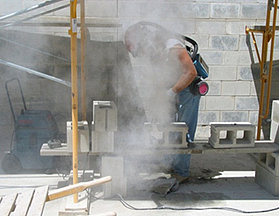 How are industry and business leaders responding to a new proposed rule on crystalline silica? OSHA claims that the new rule will save approximately 700 lives and prevent 1,600 cases of silicosis each year, but many in the construction industry are concerned that the rule is not economically feasible.
How are industry and business leaders responding to a new proposed rule on crystalline silica? OSHA claims that the new rule will save approximately 700 lives and prevent 1,600 cases of silicosis each year, but many in the construction industry are concerned that the rule is not economically feasible.
Proposed Changes to the OSHA Silica Rule
The express intent of the proposed rule is to lower worker exposure to crystalline silica, which causes silicosis, an incurable lung disease. Current standards for general industry allow up to 100 micrograms of crystalline silica per cubic meter of air. For construction and shipyards, the standard is 250 micrograms of crystalline silica per cubic meter of air. The proposed OSHA Silica Rule will lower the exposure limit to 50 micrograms per cubic meter of air, in line with recommendations made by the National Institute for Occupational Safety and Health (NIOSH).
In addition to lowering the exposure limits, the proposed rule includes provisions for the following.
- Measuring silica exposure
- Reducing exposure
- Providing medical exams to workers with high exposure
- Training workers about silica hazards
- Construction Industry Opposition
The public comment period for the proposed rule resulted in many comments against the rule, primarily from the construction industry. There were over 400 comments submitted and the opposition focused on the following key points:
- OSHA underestimated the costs associated with enforcement of the rule
- Enforcement is not economically practical
- Enforcement is not technologically feasible
- Rule is based on outdated data
- OSHA did not adequately study the affected industries
- OHSA relied on false assumptions to develop the rule
In its comments, the U.S. Chamber of Commerce pointed out that silicosis has been on a long-term decline and claimed that OSHA built their proposal for the silica rule based on incorrect assumptions that failed to take into account recent data on mortality and exposure rates.
Support from Professional Associations
The majority of the supporting comments for the proposed rule came from Professional Associations and other Safety and Health groups. The Associations that supported the proposed rule did so with conditions. The National Industrial Sand Association supported the worker protection provisions but expressed concern that compliance with the new standards is not economically feasible for businesses.
Health associations such as American Cancer Society and the American Public Health Association endorse the proposed rule with no objections. The American Society of Safety Engineers is in agreement with lowering exposure limits but also conceded that compliance to the proposed rule is probably not economically feasible.
What’s Next for the OSHA Silica ProposalInformal public hearings on the rule began March 18 and will run through April 4, 2014. We will continue to monitor this issue.

















